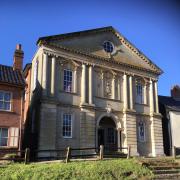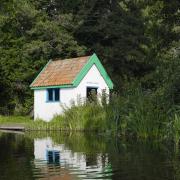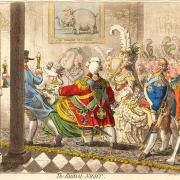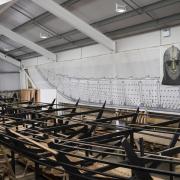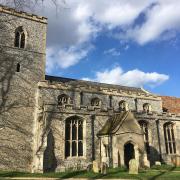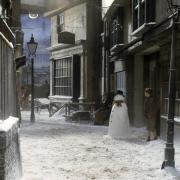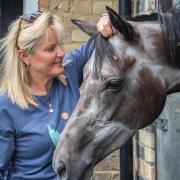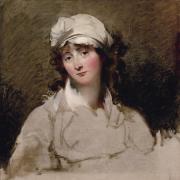What is it about something built in another age that moves people to want to protect them for all time? Rowan Mantell meets a group of people, passionate about community and heritage, who are inspired by some of Suffolk’s loveliest buildings.
In Great Waldingfield a wavy wall sashays along a road – secure in the protection of each crinkle and crankle, thanks to the work of a parish council.
In Hitcham, near Lavenham, and Little Bealings, near Ipswich, villagers throng to thriving medieval churches.
In Hadleigh scores of buildings have been gathered on to an official list of places worth cherishing.
Across Suffolk, beautiful buildings have inspired people to devote themselves to protecting them. It has taken huge amounts of time, energy and money – and made the entire county richer.
Volunteers involved in each of these projects were honoured by the Suffolk Preservation Society, winning an inaugural Suffolk Heritage Champion Award. Society director Fiona Cairns said the awards were a chance to give people ‘the recognition they truly deserve for the loving care they show our precious buildings and historic neighbourhoods.’
She said generations of members, volunteers and staff had loved Suffolk’s heritage enough to devote their time and skills to caring for it, and said the wider role of volunteers, ‘both as individual owners of buildings and collectively as campaigners to preserve and enhance local heritage sites’ inspired the launch of the Suffolk Heritage Champion Awards.
The latest award winners will be announced this spring.

Nicky and Malcolm Currie, who have lived in Hitcham for 30 years, led a project which means the village church can continue to serve its community.
‘We share a love of old buildings, especially rural churches, as they often reflect the dedication of the generations of local people who have lavished care on them over time,’ said Nicky.
‘We did it because Hitcham church matters to our village. Much of its beauty is in its simplicity and the sense of light and space on entering. There is a stunning hammer beam roof and on closer inspection a lot to interest the visitor.
‘But is a huge medieval building built as a statement of wealth by the bishops Ely. Always too big for our small village it was obvious that its future depended on it becoming a multi- purpose space.’
The £340,000 project included restoring the church bells, bell-chamber and a rare 16th century bell wheel, acquiring two new bells, moving and restoring the organ and using the freed-up space to create rooms beneath the tower.
She estimates a small team of volunteers put in more than 2,000 hours (or 285 days) of work.
‘I decided to dedicate all my spare time to applying for grants making over 50 applications in two years, of which 19 were successful,’ said Nicky. The church is now used for village meetings, classes, concerts and exhibitions, as well as services.
It has a museum-quality display about Hitcham’s most famous rector, the Rev Prof John Stevens Henslow, who was a friend and mentor to Charles Darwin, and the scientist whose agricultural discoveries inspired the formation of fertiliser firm Fisons, originally based in Ipswich. He taught at Cambridge University, tutored Queen Victoria’s children, launched a school and adult education classes in Hitcham and helped establish Ipswich Museum.
The work uncovered a ship carved into the stone of the church’s oldest door, ‘probably scratched as a prayer for safe return before the days when people could write,’ said Nicky, and the names of past bell-ringers written on the underside of the tower steps recording events including a harvest festival peal during the First World War. ‘Poignantly, they could only get four men to ring,’ said Nicky.
Nicky and Malcolm learned to ring as part of the project, helped by the ringers of Rattlesden.
Now Hitcham has a team of 12 ringers ensuring the church bells sound out every Sunday.

Hadleigh has an abundance of beautiful listed buildings and its history, architecture and sense of community was one of the reasons Richard Fletcher and his wife, Jenny, moved to the town more than 20 years ago.
After retiring Richard became increasingly involved in the Hadleigh Society. Worried that, with considerable expansion expected, significant historic sites might be damaged or lost, he helped identify almost 100 places in Hadleigh which, while not officially listed, deserved special consideration in planning policies and decisions.

He organised surveys of buildings, researched their history and compiled the first official Local List for Hadleigh. Entries include a medieval hall house which became Hadleigh's ‘Pest House’ for smallpox patients, the imposing Victorian terrace, Isonomy Cottages, on Benton Street, the Salvation Army hut, which is more than 100 years old and stood on Hadleigh Airfield in the First World War, and the music and arts centre on Bridge Street which was a school from 1853 to 1968.
And the list is still growing. When Richard was contacted by people concerned that a historic track was threatened by new building, members of the Hadleigh Society showed Bacon Lane was a medieval holloway, or hollow way, path. It is now protected through the Local List.

Just outside Hadleigh is 16th century Benton End, once the home of artists Cedric Morris and Arthur Lett-Haines. Together they founded the East Anglian School of Painting and Drawing here, with students including Lucian Freud and Maggi Hambling. Cedric’s garden was famous for its collection of rare plants, including the bearded irises he bred here, naming 90 different cultivars, many with a ‘Benton’ prefix. Vita Sackville-West, Beth Chatto, Elizabeth David, Constance Spry and Benjamin Britten were frequent visitors.
Now the charity The Garden Museum is reviving Benton End as a centre of artistic and horticultural education. It is applying for grants and has run tours and fundraising open weekends, made possible by local volunteers. More volunteers from Hadleigh Environmental Action Team visit fortnightly to help restore the garden. Benton End manager Matthew Hodges said: ‘In Cedric Morris and Arthur Lett Haines’ time this house and garden was full of life, art, plants and food! Their spirit lives on and we look forward to sharing that.’ And he said it is that spirit which inspires people to devote their time and energy to Benton End.

At Little Bealings, volunteers raised more than £200,000 to create a community hub in All Saints Church, ensuring the church remains at the heart of village life.
‘We cannot lose these amazing spaces. They connect us to the land, to our friends and neighbours, to history,’ said Helen Clarkson-Fieldsend. ‘Every day we enter the church, we see the list of vicars on a plaque – the first was here in 1296! That history is our heritage and belongs to all of us in the village today, whether we are churchgoers or not, and we wanted to honour that.
‘So many churches in small villages are not used very often—sometimes only one or two hours a month for services—and yet they are sometimes the only local gathering place in a village.

‘We wanted to preserve the heritage that everyone loved so much, but also to re-establish the church at the heart of the community. We also wanted to create a space that was welcoming to all since many people, even those school parents who walked by the building every day, hadn’t discovered how beautiful, peaceful, and friendly a place our church is.’
Now the church has a cafe and bookshelf shop and is used for everything from a dog scent training workshop to a cinema club and choirs to quizzes.
‘We assembled a team of volunteers with a broad range of expertise including experts in heritage, youth work, café start-ups and management, music, art, education, finance, and gardening,’ said Helen.
They secured grants to upgrade everything from the plumbing to the pews.

‘It feels wonderful to see the church come to life, filled with so many people, some of whom never walked into the building despite living in the village for many years,’ said Helen.
‘We still have a central focus on services and worship, and we have seen the church filled on special services such as Stir Up Sunday, the carol service, at Easter and during the flower festival. But churches can be so much more and do so much more to enrich the lives of local residents and visitors and it will all serve to keep the church at the heart of the community.
‘In medieval times, the church was where the cattle auction was held which shows us that these spaces, while sacred, can also encompass so much more, highlighting our heritage and offering spiritual comfort to all who need it.’

Great Waldingfield’s crinkle crankle wall is protected for future generations as a listed structure thanks to Linda Rushton and fellow parish councillors.
Linda has loved the wall since childhood. Even before she moved to the village more than 30 years ago her father would drive from their Essex home to Suffolk every Sunday, and a highlight of the family trips was seeing the wonderfully wavy wall.
The term crinkle crankle refers to sinuously curving brick walls, often enclosing gardens, and particularly found in Suffolk. Linda is especially fond of the setting, with its Victorian farmhouse, pretty gardens and views to the church.

‘The 10 crinkles and crankles shining in the sun - absolute Suffolk perfection,’ said Linda. ‘There’s a new bench near Great Waldingfield church where you can sit and watch the sunset behind the wall, it is so beautiful.’
Motivated by fears that the much-loved landmark was not officially protected, and by then a parish councillor, she began researching how to get it listed.
'It was a highlight of my nine years as a parish councillor. The entire council came together to support the listing application,’ she said.
‘Crinkle crankle walls are about as Suffolk special as you can get.’









